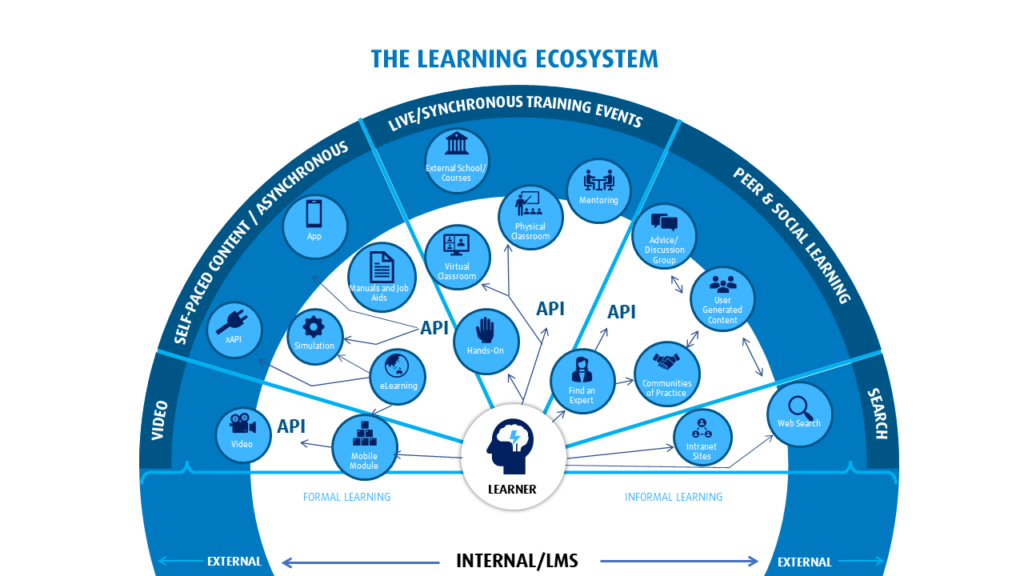Custom learning thrives in the right ecosystem, but we see so many organizations get this wrong. A learning ecosystem is used to describe the overall learning environment within a business. It encompasses the tools, resources, and technology used to develop the overall system. In order to fully benefit learners and meet organizational priorities, we must dissect it and look much deeper than the surface.
Features of a Learning Ecosystem
An ecosystem is defined as a community where organisms all interact with each other to survive. If all elements are present, then everything thrives. But if one piece is missing, then the entire ecosystem is thrown out of balance.
Learning and development adopts this concept to define the way characteristics of the learning experience interact with each other. There are numerous tools, technologies, and resources that work in unison to support knowledge and skills in the learner. If one thing is missing, the entire process can be thrown out of balance.
The overall goal is to create an ecosystem that provides learners with the tools they need to excel. It’s a symbiotic relationship between learners and the content. Here are some of the characteristics that comprise a healthy learning ecosystem.

Learning Ecosystem
Learner Centric
Creating an experience that caters to the learner is perhaps the most important characteristic of a custom learning ecosystem. The number one goal must be bringing value to the learner.
Certain elements of the learning ecosystem are designed for individual use while others are more socially focused. Both must work toward achieving the same overall goal.
Learning ecosystems often combine content created by L&D with social mechanisms that allow for user-generated content. Think how LinkedIn seamlessly merges these two approaches. They built a social platform with socially cultured content and sprinkled in curated content. Linked In itself is often one element of a learning ecosystem.
Highly Adaptive
A custom learning ecosystem must meet the demands of an ever-changing business landscape. Departments have different requirements so L&D must provide the right components for each area to succeed. As an example of how to be flexible to the changing business requirements, virtual classroom, the company intranet, and communities of practice may exist together on the same topic. Formal training alone is not the only solution in a learning ecosystem.
Healthy learning ecosystems all leverage a variety of resources to address performance issues and create opportunities for employees to learn. Using a single solution is not enough. Custom learning is often within the ecosystem as one of a variety of tools to boost efficiency.
Ecosystems evolve over time. This is just as true with learning as it is in nature. Elements that are critical for learning today might be obsolete next year. Custom learning (whether performance support tools or a structure for peer coaching) within the ecosystem factors in the ever-changing business landscape and allows the ecosystem to evolve to changes in the workflow.
Corporate Culture Influence is Woven In
Organizations have a defined culture. The success of learning is dependent on this culture. There are certain cultural requirements that make a learning ecosystem thrive. The organization must adopt an approach that encourages user acceptance and participation.
Performance Support Provided in the Moment of Need
Modern learners need their learning experiences to align with their job. A thriving ecosystem guarantees that they have access to the right information in their moment of need. The goal is to provide content that can be accessed at any time without disrupting their job process.
This benefits both the employee and organization equally. Employees have their questions answered when they need it. At the same time, the organization gets a reduction in costly mistakes and a boost in performance.
Includes Self-Paced
The preferred learning environment has given birth to a demand for self-paced learning. Rather than having scheduled classes and boardroom training sessions, much of the information is consumed at the learner’s discretion.
Simulations, eLearning, and mobile apps are three examples that are used in self-paced learning development systems. Of course, the benefits do come with a number of challenges. With self-paced learning, technological bottlenecks such as slower content updates and distribution can create problems. The other challenge is accountability. Fortunately, other elements of a learning ecosystem offset these challenges.
Supported by Technology
Although technology is an essential asset to creating a great custom learning platform, it must have support from other assets. Its purpose is to enable the ecosystem, but it requires the right content, people, and processes for it to work efficiently.
An ecosystem also needs to have data-tracking capabilities. Adding smart tracking tools to analyze employee interactions with the learning content are important. This helps L&D optimize the content to improve its efficiency.
Enabled by Experts
There are times when a worker needs help from an expert. Sometimes it’s coaching and other times it’s just assistance with an everyday task. The modern learning approach takes this into account by providing a way for employees to easily access this help. Enabling experts leverages their expertise. Fortunately, there are a lot of tools that allow seamless collaboration from experts.
Benefits of a Custom Learning Ecosystem
Just like in nature, a learning ecosystem exists in a state of symbiosis. Learners interact with a balance of content, technology, and data that guides their learning experience. The learning content is guided by the organization, but the learner decides the exact path they take to get there.
Having a thriving ecosystem benefits both the company and the learner. Both should be rewarded at the end of the journey.
A learning ecosystem adds agility to a company’s training and development. Today’s business economy is rapidly changing so custom learning provides the ability to respond quickly. Content can easily be adapted to new changes.
Other benefits that come with adopting a healthy learning ecosystem include:
- Standardization of content to help learners have access to the same learning experience.
- Information is available in their moment of need and doesn’t disrupt the normal flow of work.
- It’s scalable so it will grow alongside of the organization.
Final Thoughts
The role of custom learning is to support various elements of the learning process. In order for this to occur, the learning ecosystem must be allowed to thrive. The right type of learning content must be readily available to meet learners in their moment of need. That’s why learning ecosystems unite learners with technology, content, and data for continuous growth.


Recent Comments